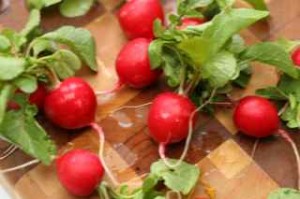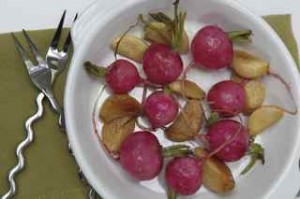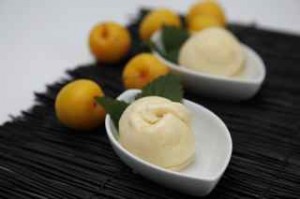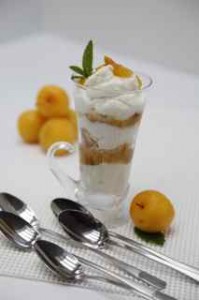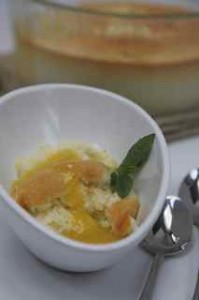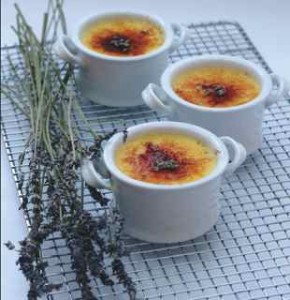 Maureen McSween of Quiet Acres Farm in Niagara-on-the-Lake couldn’t have planned a better day for a group of food writers and bloggers to visit her farm. The sun was soft, peaking from behind the light cloud cover ever so often while a cool breeze rustled the leaves of the orchard and kept us all cool and comfortable on a warm July day.
Maureen McSween of Quiet Acres Farm in Niagara-on-the-Lake couldn’t have planned a better day for a group of food writers and bloggers to visit her farm. The sun was soft, peaking from behind the light cloud cover ever so often while a cool breeze rustled the leaves of the orchard and kept us all cool and comfortable on a warm July day.
Quiet Acres is a 300-acre tender fruit farm with a market stand on Lakeshore Road. For the market, they grow a variety of vegetables from peppers and eggplant to garlic and zucchini. From the vegetables Maureen offers up garlic scapes and zucchini flowers for her foodie customers.
Today, food writers from Toronto, Hamilton and Niagara came together because the farmers advocate organization, Farmers Feed Cities (www.farmersfeedcities.com) wanted to let everyone know that while the harvest is in full swing, it’s the perfect time to think about preserving the seductive flavours of summer for an entire year of enjoyment. So they invited a group of 8 food writers and bloggers who’s job it now is to spread the tasty word.
 As we walked through the peach orchard laden with peaches, the aroma was intoxicating and immediately converted them to the cause of local food – no grocery store peach display ever smelled this good. The cherry orchard was barren, the empty trees a reminder of a season coming to an end and then we rounded the end of the orchard to find ourselves face to face with Lake Ontario.
As we walked through the peach orchard laden with peaches, the aroma was intoxicating and immediately converted them to the cause of local food – no grocery store peach display ever smelled this good. The cherry orchard was barren, the empty trees a reminder of a season coming to an end and then we rounded the end of the orchard to find ourselves face to face with Lake Ontario.
We all stood in stunned silence for a moment, listening as the waves lapping the shoreline 8 feet below. It was a beautiful sight that captured our spirits in the most incredible farm and country tranquility. Maureen cautioned about getting too close to the edge of the cliff. Each winter eats away at their land, the icy waves crash against the fertile, sandy soil and it caves in. Each spring the McSweens remove one more row of fruit trees to keep the orchard and their workers safely away from the edge of the land.
Here there was a table dressed in white linen with drinks and orchard fruit to feast on before we collected our peaches and headed off to Southbrook Winery for a vineyard patio lunch and a session on canning summer produce.
Local food expert and amazing chef, Stephen Treadwell served up some casual salads and amazing pizzas mostly made from the grape skin powder that Southbrook makes from the remaining grape skins after harvest. This amazing product has a high concentration of Reversatrol, the anti oxidant celebrated in the CBC documentary, The French Paradox. The anti oxidant comes from the skins of red grapes. When the grapes are pressed in the production of red wine, the remaining skins, traditionally used as vineyard compost, are instead dried, pulverized and made into a powder that can be added to any baked goods from pizza crust to bread, and pastries to donuts. Chef Treadwell not only makes amazing pizzas from it, but there are always a few loaves of bread on the counter that eager customers are happy to scoop up.
Next it was time to preserve our peaches and we walked through the winery into the private culinary studio that overlooked the vineyard. There was a big bowl of peaches on the counter covered in their fuzzy bloom, still warm from the sun. Everyone gathered around as I, The Ontario Table author, put on my apron and began washing peaches in cool water. I shared my stories of canning as a young girl growing up and about the joys of opening a jar of peaches on a cold winters day. For me, each bite fills my psyche with the warmth of a hot summers day and fills my mind with memories of the day the jars were filled with fresh peaches.
 We dunked the peaches in a pot of boiling water and let them sit for a minute before scooping them out and rubbing off the peels. For some of the more stubborn peaches (unripe) I peeled them with a knife. The peaches were sliced and jars filled. When the light simple syrup boiled on the stove, it was removed and poured into the jars of peaches. Hot lids were attached and the jars were plopped into a large pot of boiling water wrapped in kitchen towels.
We dunked the peaches in a pot of boiling water and let them sit for a minute before scooping them out and rubbing off the peels. For some of the more stubborn peaches (unripe) I peeled them with a knife. The peaches were sliced and jars filled. When the light simple syrup boiled on the stove, it was removed and poured into the jars of peaches. Hot lids were attached and the jars were plopped into a large pot of boiling water wrapped in kitchen towels.
Traditionally, canning pots come with racks to fit the jars into, but this pot was just a bit too small for the canning racks. The purpose of the rack is to keep the jars from touching the bottom of the pot where they most certainly would crack and break. To replace the rack, I wrapped each jar in a clean kitchen towel and lowered it into the boiling water to process for 10 to 15 minutes. When the jars were removed from the water they were placed on a clean kitchen towel again and within minutes, the jars began to pop.
The canning pop Pokies is the last step in the canning process. It is a sign that the jar have sealed themselves and will be safe to eat throughout the year. The lid concaved inward from the vacuum created from the cooling liquid inside and will stay that way until it is opened later in the year.
As the lady bloggers and writers climbed back into the Farmers Feed Cities limousine to head back to their respective towns, their bags were laden with glistening jars of peaches, crimson jars of rose soaked cherries and clear jars of candied garlic cloves. They had books and wine, canning recipes and an excited energy they intended to spend canning the seasons remaining produce – or at least to eat it and write about it. Thank you Farmers Feed Cities on behalf of those of us who love to discover the best food in this glorious province.
Watch for stories from the following food writers and bloggers:
Becca Lemire, Urban Blogger, www.shedoesthecity.com
Victoria Weiss, Blogger, www.momwhoruns.com
Sandy Avvari, food blogger, www.milkandeggs.wordpress.com
Alex Ward, food blogger, www.freshjuice.ca
Sara Graham, blogger, www.thetravelpresse.com
Jennifer Lee, blogger, www.fillermagazine.com
Liz Campbell, food & travel writer, Fork on the Move, www.lizcampbell.ca
Barbara Ramsay Orr, food & travel writer, @orracle
Daniela Payne, Canadian Living web editor, www.canadianliving.com
For more recipes or ideas on how to use those canning jars once you’ve eaten the delicious contents, click here.

Peaches in Simple Syrup – Simply Devine!
9 peaches
1 cup sugar
3 cups water
6-250 mL canning jars complete with lids
To ripen your peaches, lay a piece of cardboard or newspaper on the floor of a garage or any enclosed space that is warm. Lay the peaches in a single layer and leave for a few days. When the peaches are very soft, bring them inside and wash them gently, making sure you remove as much of the peach fuzz as possible. This will eliminate much of the itchiness when working with peaches.
On the stove you’ll need a small pot with 2-inches of water, a medium pot for the simple syrup and a large canning pot with approximately 8-inches of water. Bring the canning pot to a boil over high heat. Meanwhile, add the sugar and water to the medium pot and bring to a boil over high heat until the sugar has melted. Remove from heat. Put the canning lids in the small pot and bring to a boil. When the water boils, turn off the heat and leave the lids in to soften.
Lay a clean kitchen towel on a work surface and place the clean, empty jars on top. When the water in the canning pot is boiling, turn the heat off and carefully drop the peaches into the hot water. Leave for 1 to 2 minutes depending on how ripe your peaches are. If they are really ripe they will need less time.
Carefully remove the peaches and immediately put them in a bowl of ice water to stop the cooking and make them easier to handle. Remove a peach from the ice water and with a knife, make a slit in the top of the peach. With your fingers, slide the skin off. If there are spots that are difficult, use a knife and peel it. The skin of ripe peaches will fall off very easily; the more unripe peaches are, the less likely they are to let go of their skins.
Once peeled, put the peach back into the ice water and continue until all peaches are peeled. The water will keep them from oxidizing. Now pit and slice the peaches. Put the slices into the clean empty jars. You may want to maneuver them around to eliminate any empty spaces in the jars. Leave about ½-inch space on the top. Continue filling jars.
When all of the jars are full of peaches, fill with simple syrup, leaving about ½-inch or slightly less of headspace. Do not fill to the top. Carefully wipe the top of the canning jars with a clean paper towel. Using a magnet, lift the lids from the hot water and place on top of each jar of peaches. Secure a ring over the lid and don’t tighten too firmly.
Place jars in a canning rack and put in the pot of hot water and turn the heat to high. If you don’t have a canning rack, put a tea towel in the bottom of the canning pot so the jars don’t touch the bottom of the pot, wrap each in another kitchen towel and proceed. When the water begins to boil, boil for 10 – 15 minutes more.
Remove the jars with canning tongs and lay each one on a clean kitchen towel on the counter. Within minutes the lids will begin to pop as the jars seal themselves. Now you can store your beautiful jars of peaches in the cantina or cupboard until you’re ready to enjoy them. Makes 6-250 mL jars.
 There is a reason why traditional grocery stores are always at the bottom of the list of places I shop.
There is a reason why traditional grocery stores are always at the bottom of the list of places I shop.
